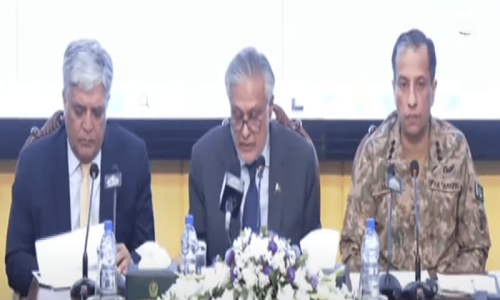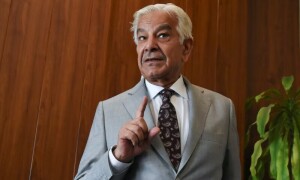
PAKISTAN’S provincial water disputes — particularly between Sindh and Punjab — remain unresolved even three decades after signing of the Water Apportionment Accord to share waters of the Indus river basin. The accord is based on the historical use of water by the provinces and was expected to resolve the simmering disputes between them, once and for all. It didn’t, however.
Sindh continues to feel the most aggrieved since the accord doesn’t guarantee the minimum “environmental flow” of river waters through the province and into the sea, according to water experts. A lack of trust of the lower riparian on equitable water distribution has led Sindh to accuse Punjab of stealing its share leading to a serious impact on its delta ecosystems. Punjab has reservations over the data of water losses between the barrages of Sindh, alleging that it misreports water flows.
Sindh believes that the extraction of water for building dams and irrigation in upstream provinces will deprive it of its needs. There is also a consensus within Sindh that the then PML-N government had pulled off the accord through coercion. It is, therefore, not surprising that PPP Chairman Bilawal Bhutto-Zardari has called for a new inter-provincial water-sharing arrangement as Punjab and Sindh lock horns over the volume of water shortage and how to share it.
Engineers and scientists have, on the other hand, called for fresh studies on water availability in the system, as climate change and rapid population growth over the last three decades are believed to have reduced its flows. “We need to update water data on the basis of historic flows and employ telemetry to monitor flows at different points in order to fairly distribute water among the provinces,” said one water researcher.
Irsa chief says it is purely a technical issue
Researchers have consistently argued that the 1991 agreement is ambiguous and open to interpretation. For example, it stipulates allocation of 114.35 million acre feet (MAF) of water during Kharif and Rabi seasons, while there was never this amount in the system. It also does not specify how the shortages will be shared if the volume available is less than the assumed flow.
It says the ‘record of actual average system uses for the period 1977-82 would form the basis of sharing the shortages and surpluses’. This is particularly controversial for Sindh, according to water experts, since it suggests that the provinces with water storage capacity and infrastructure by 1977 now have a prior claim over all surpluses, according to independent experts.
In 18 out of 28 years, the water shortage has ranged between 10pc and 28pc, according to the Indus River System Authority (Irsa) data between 1993 and 2020. For the remaining 10 years, the shortages were calculated between 4pc and 9pc. The situation for Rabi crops has been even worse with the deficit fluctuating between 10pc and 48pc during 17 years.
Punjab Irrigation Minister Mohsin Leghari blames the distribution of water on the “hypothetical” figure of 114.35MAF though the availability was only 102.73MAF at the time the agreement was signed. “The hypothetical figure was adopted with the understanding that more reservoirs would be constructed to increase water storage. Half of the new available water, 5.5MAF out of 11MAF, was promised to be given to Sindh, 1MAF to Punjab and the rest to the other federating units. This would reduce Punjab’s percentage share from 53pc to 49pc and enhance Sindh’s from 42pc to 43pc.”
He says Sindh demands that it be given its share precisely as per the accord, though new dams have not been constructed yet, and the drop in storage capacity of existing dams not be considered while deciding its share. “It tends to ignore that flows from eastern rivers – Ravi, Beas and Sutlej – have decreased from an average of 9.35MAF in 1976-99 to 3MAF, most of which is during flood season, after 2000-01. Punjab is ready to accept this demand only after water availability is increased to the assumed 114.35MAF.”
Mr Leghari also accuses Sindh of under-reporting the inflow at its barrages and canals. “Irsa and joint teams of Punjab and Sindh have time and again detected this misreporting. Its documented evidence is signed by none other than the Sindh member himself.
He further says Punjab supports transparency in water distribution through telemetry to monitor inflows and outflows at any given time. “We also demand proper water accounting, as every drop matters. With a 49pc share, Punjab is irrigating 21.71 million acres to produce over 75pc of the country’s agricultural produce, while Sindh’s share is just 20pc from its 12.81m acre command area with 43pc water consumption. Is this a judicious use of water?” he asks.
Shortages hit Sindh crops
Meanwhile, Sindh wants its water share on the basis of availability of the 114.35MAF assumed in the accord. It claims that the province faced 37pc shortages when Irsa applied 32pc for Punjab and Sindh. In view of the persistent shortages, the Guddu chief engineer has requested paddy growers not to go for sowing in May and June as the barrage is experiencing the worst water shortage in 60 years. He anticipates better water flows, though.
Sindh’s Irsa Member Zahid Junejo hopes the water situation will improve in view of the rising temperatures in upper reaches that may lead to improved flows. “But for now, both cotton and paddy crops in the province have been adversely affected because of water shortages.”
Sindh has always pressed one point: give us our share of water in line with the 1991 accord. “We don’t accept the three-tier formula, which is the bone of contention,” Junejo says. He rejected Punjab’s allegation of Sindh fudging figures.
“We check water flows at every point. Punjab and Sindh have consented to the formation of a committee to monitor water discharges through independent inspectors,” he says, dismissing the claim by Irsa and Punjab that Kotri downstream flows are wastage of water. “People live downstream Kotri. Calling the flows a waste of water is simply not understandable.”The member claims that around 50,000 acres of land is irrigated in Punjab’s riverine area from Sindh’s share. “When Irsa decided with 3-1 votes in the May 24 meeting that Taunsa-Panjnad link canal should not be opened, Punjab did not implement it to the disadvantage of Sindh where farmers have considerably lost their early sowing of Kharif crops.”
Irsa chairman Rao Irshad Ali Khan contends that unfortunately, the provinces are making an unnecessary political problem out of a purely technical issue. Commenting on Sindh’s demand for his removal, he refused to get involved in any political controversy. “It is unfortunate that the Irsa member from Sindh went public and received a similar response from Punjab with the authority caught in the crossfire,” he told Dawn from Islamabad.
Explaining the technicality of water politics, Mr Khan said Irsa, being the regulator, acts very cautiously, especially during the early Kharif season when the country is going through extreme water poverty, as apart from the calculated national shortages during this period, agriculture requirements provide the distribution context.
In April, Sindh was sowing cotton and needed more water. It was given additional water on the basis of 17pc shortages against 22pc for Punjab to complete its sowing. In May, Punjab was compensated for its April loss and the share of both provinces would be equalised by June 10 when the early Kharif cycle ends. “Where is the putative discrimination,” Mr Khan wonders.
Published in Dawn, June 6th, 2021













































